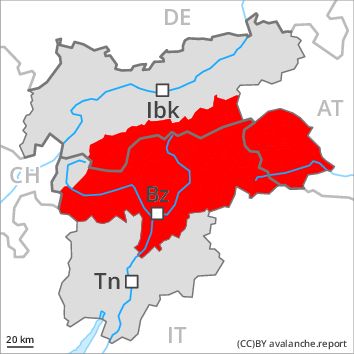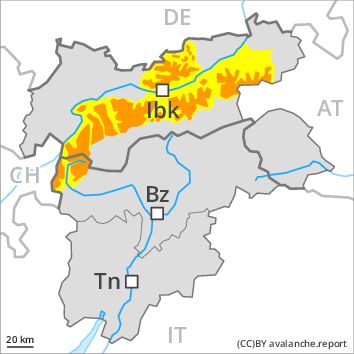Regions
Sexten Dolomites, Schnals Ridge, Southern Stubai Alps, Southern Zillertal Alps and High Tauern, Saldurn-Mastaun Ridge, Texel Mountains, Sarntal Alps, Western Pfunderer Mountains, Eastern Pfunderer Mountains, Durreck Range, Weißkugel Range, Western Rieserferner Mountains, Gurgler Range, Western Deferegger Alps, Central Stubai Alps, Ortler Range, Northern Zillertal Alps, Ulten Valley, Venediger Range, Eastern Nonsberger Alps, Eastern Rieserferner Mountains, Northern Dolomites of Fiemme, Glockner Range, Gröden Dolomites, Eastern Deferegger Alps, Prags Dolomites, Schober Mountains, Lienzer Dolomites

Danger level
Avalanche Problem
Gliding snow above 2500m, N-NE-E-SE-S-SW-W-NW
Wind-drifted snow above 2000m, N-NE-E-SE-S-SW-W-NW

Numerous large and, in many cases, very large natural avalanches are to be expected as the precipitation becomes more intense. A critical avalanche situation will prevail.
As the precipitation becomes more intense numerous natural avalanches are to be expected, even very large ones. Gliding avalanches and dry slab avalanches are the main danger. On steep grassy slopes numerous medium-sized and large gliding avalanches are to be expected below approximately 2500 m. In the regions where a lot of rain falls the danger will increase more quickly.
As a consequence of warming, the likelihood of dry slab avalanches being released will increase appreciably. Numerous large and, in many cases, very large avalanches are to be expected, this applies in particular from early morning. The prevalence of avalanche prone locations and likelihood of triggering will increase with altitude.
Additionally in some places dry avalanches can also be released in near-ground layers and reach very large size as the day progresses. This applies in all aspects in high Alpine regions.
Outside marked and open pistes a critical avalanche situation will prevail.
Snowpack
dp 2: gliding snow
dp 6: cold, loose snow and wind
Over a wide area 50 to 80 cm of snow, and up to 120 cm in some localities, fell. Over a wide area 50 to 80 cm of snow, and even more in some localities, will fall above approximately 1500 m, especially in the east. The wind will be strong to storm force. As a consequence of fresh snow and a storm force southerly wind, extensive wind slabs will form in all aspects.
The snowpack will be generally prone to triggering. Over a wide area fresh snow and wind slabs are lying on soft layers, especially above approximately 2000 m. The old snowpack will be unstable in high Alpine regions. Dry avalanches can be released in near-ground layers.
The snowpack will become wet all the way through at low and intermediate altitudes.
Tendency
Gradual decrease in avalanche danger.
